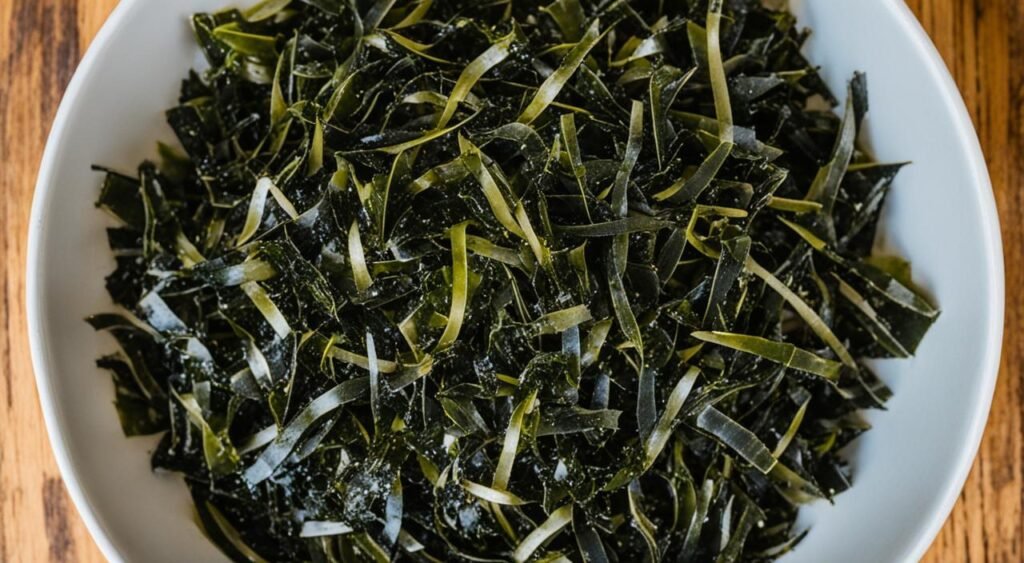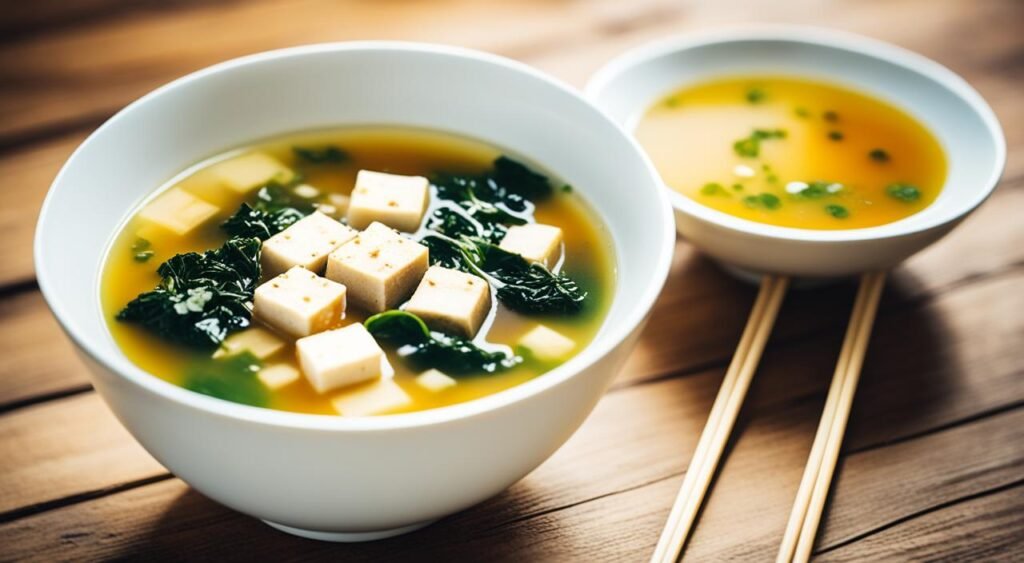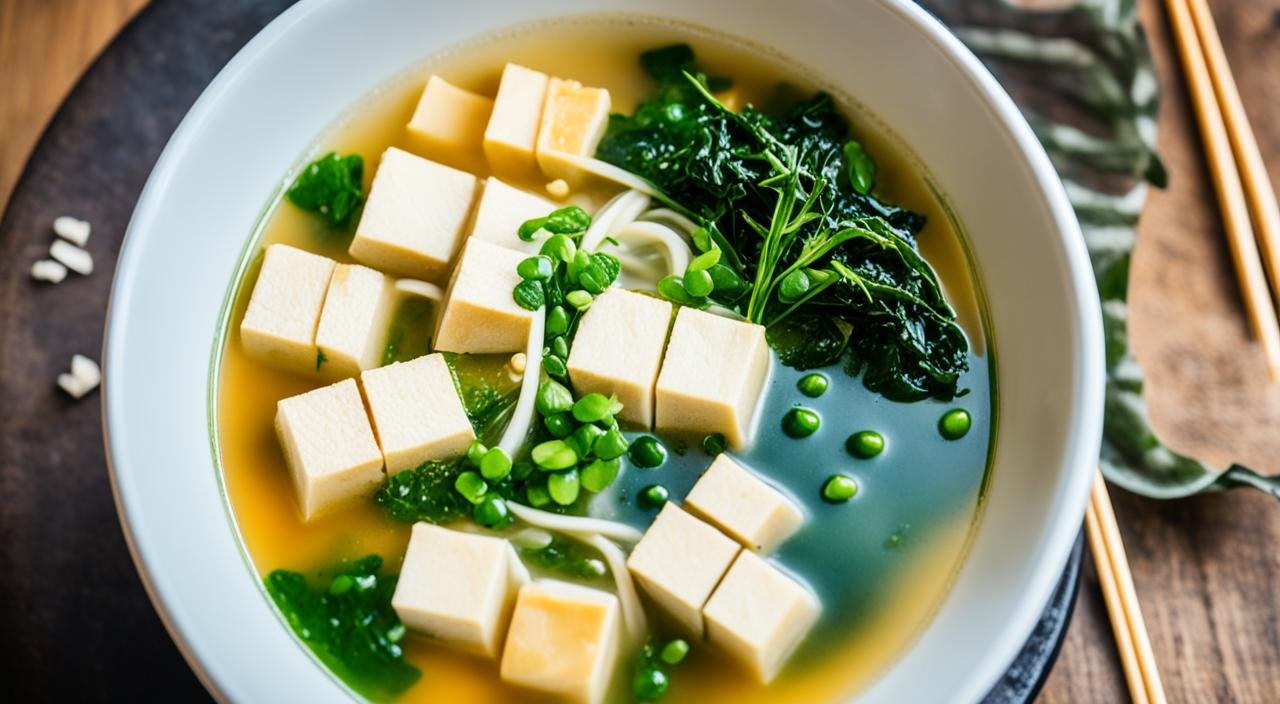Is Miso Soup Gluten Free? Most people get this wrong and pay the price. Learn which brands are safe, avoid costly mistakes, and enjoy worry-free miso soup today.
Miso soup is a favorite in Japanese cuisine, loved for its tasty flavors and warm comfort. But, if you’re on a gluten-free diet, you might wonder if it’s safe to eat. We’re here to look into this dish and give you the info you need to enjoy miso soup worry-free.
Key Takeaways
- Miso paste, the main ingredient in miso soup, is usually gluten-free if it comes from fermented soybeans.
- But, there’s a risk of gluten getting in, so picking certified gluten-free miso paste is key.
- The broth for miso soup can be gluten-free with seaweed or fish-based stocks.
- Adding gluten-free toppings lets you make miso soup that fits your diet.
- When eating out, ask about the ingredients and how they make the soup to be sure it’s gluten-free.
What is Miso Soup?
Miso soup is a tasty traditional Japanese soup. It’s also known as miso-shiru in Japanese and miso-tang in Chinese. It’s made with a fermented soybean paste called miso and a rich dashi broth.
Traditional Japanese Soup Made with Miso Paste
Miso paste is the key ingredient in this soup. It’s made by fermenting soybeans with a special mold. This makes the paste taste umami, which is what makes miso soup so special.
The color of miso paste can vary from white to red. Each color has its own unique taste. The longer it ferments, the deeper the flavor.
Dashi Broth as the Base
The dashi broth is the base of miso soup. It adds a savory and aromatic taste. You can make dashi with konbu (kelp) or bonito flakes. Each gives a different flavor.
This mix of rich miso paste and tasty dashi broth makes a perfect soup. Miso soup is a big part of Japanese food. It’s often eaten for breakfast to start the day off right.
You can add many things to miso soup, like tofu, veggies, and seafood. This makes it a dish you can change up easily.
Health Benefits of Miso Soup
Miso soup isn’t just tasty – it’s good for you too! Think of it as a warm hug for your stomach. The fermented soybeans in miso paste contain probiotics, which are tiny helpful bacteria. These good bugs help your tummy work better.
My grandmother always said, “A bowl of miso soup a day keeps the doctor away.” She might have been onto something. Studies show that people who eat fermented foods like miso have better gut health within just 4 weeks.
Here’s what one cup of miso soup gives you:
- Only 30-50 calories (that’s less than an apple!)
- 2 grams of protein
- Helpful probiotics for digestion
- B vitamins that give you energy
But watch out – miso soup has lots of salt. One bowl can have 800-900mg of sodium. That’s like eating 3 bags of potato chips! If you’re watching your salt, use less miso paste or drink extra water.
People with celiac disease often feel better when they eat probiotic foods. It’s like giving your hurt intestines a healing helper.
Is Miso Soup Gluten Free?
Miso soup is great for a gluten-free diet. Just use gluten-free miso paste and dashi broth without wheat. Traditional miso is from soybeans. But, some kinds have wheat or barley, which aren’t gluten-free.
For a gluten-free miso soup, pick miso paste labeled “gluten-free”. It should be made from gluten-free soybeans like white or awase miso. Also, the dashi broth must be gluten-free. Use konbu (kelp) or bonito flakes for it.
- Gluten-free miso paste is available for those with dietary restrictions.
- Dashi granules, a key ingredient in miso soup, can be found in Japanese, Taiwanese, and Korean grocery stores, or online.
- Popular types of dashi granules include konbu stock (kelp-based) and bonito dashi granules (fish-based).
By choosing gluten-free miso and dashi, we can enjoy miso soup’s rich taste without gluten worries. With care, we can keep enjoying this Japanese dish while eating gluten-free.
Gluten-Free Miso Paste Options
Enjoying miso soup on a gluten-free diet is easy with the right miso paste. There are many gluten-free options that make a tasty and safe soup.
Shiro Miso (White Miso)
Shiro miso, or white miso, is a top pick for gluten-free miso soup. It’s made with less soybeans and koji, and ferments for under a year. This gives it a sweet, mild taste perfect for soups and sauces.
Awase Miso (Combination of White and Red Miso)
Awase miso is another great choice. It mixes white and red miso for a deeper flavor. This blend makes your miso soup richer and more complex.
Gluten-Free Miso Paste Brands
When buying gluten-free miso paste, look for brands that say it’s gluten-free. Brands like Thrive Market Organic Miso Paste and YUHO Organic Miso Paste are good choices. Clearspring Sweet White Miso Paste, Hikari Shinshu Miso Paste, and Miso Master Miso Paste are also safe options.
These brands are tested and certified to be gluten-free. By picking these, you can enjoy miso soup without gluten worries. Try different types to find what you like best.
Understanding Cross-Contamination Risks
Here’s the tricky part that catches many people off guard. Even if your miso paste says “gluten-free,” it might still make you sick. How? Cross-contamination is like when peanut butter gets on your jelly knife – one tiny bit can cause big problems.
Many miso factories also make products with wheat. Imagine a cookie factory that also makes crackers. Even if they clean the machines, tiny wheat bits might stick around. For someone with celiac disease, even 20 parts per million of gluten (that’s smaller than you can see!) can cause stomach pain.
Look for these warning signs on labels:
- “Made in a facility that processes wheat”
- “May contain gluten”
- No gluten-free certification symbol
Sarah, a celiac mom from Texas, learned this the hard way. She bought miso paste that didn’t have wheat in the ingredients. But after eating her homemade soup, she got sick for three days. The package had tiny print saying “made in a shared facility.” Now she only buys certified gluten-free miso with the official symbol.
The rule? When in doubt, throw it out. Your health is worth more than saving a few dollars.
Making Gluten-Free Dashi Broth
To make a tasty gluten-free miso soup, start with a great dashi broth. Dashi is key in many Japanese soups and dishes. You can make a gluten-free version with konbu (kelp) or bonito flakes.
Konbu (Kelp) Stock for Vegetarian/Vegan Miso Soup
Konbu is a type of dried kelp. It makes a savory, umami-rich dashi broth. Soak dried konbu in water for 30 minutes to an hour. Then, heat it until it’s almost boiling.
Remove the konbu before it boils. This makes a gluten-free base for your vegetarian or vegan miso soup.
Bonito Flakes for Fish-Based Dashi
For a deeper flavor, use bonito flakes. These flakes come from dried and fermented skipjack tuna. They don’t have gluten. Simmer the flakes in water for 10-15 minutes, then strain the broth.
Choosing konbu or bonito dashi makes sure your broth is gluten-free. This lets you enjoy traditional Japanese miso soup safely. With a bit of prep, you can have delicious miso soup without gluten worries.

Store-Bought vs Homemade: What’s Worth It?
Let’s talk money and time – because both matter when you’re feeding yourself or your family.
Homemade Miso Soup:
- Costs about 50 cents per bowl
- Takes 15 minutes to make
- You control every ingredient (no nasty surprises!)
- Tastes fresher than store-bought
Restaurant Miso Soup:
- Costs $3-5 per bowl (that’s 10 times more!)
- Ready in 5 minutes
- Risk of gluten contamination
- Sometimes too salty
Instant Miso Packets:
- Cost $1-2 per serving
- Ready in 2 minutes
- Often contain wheat (read labels twice!)
- Tastes like cardboard compared to fresh
My friend Jake did the math. His family of four loves miso soup twice a week. Buying it at restaurants would cost $1,560 per year. Making it at home? Just $156. That’s enough savings for a nice vacation!
The winner? Homemade wins by a mile. It’s cheaper, healthier, and you know exactly what’s in it. Plus, your kids will think you’re a cooking superhero.
Customizing Your Gluten-Free Miso Soup
Once you have the gluten-free miso paste and dashi broth ready, the fun part begins – customizing your miso soup! This versatile dish lets you add many tasty ingredients. You can make a meal that fits your taste. Let’s look at some great additions to make your gluten-free miso soup even better.
Start by picking your favorite vegetables. Daikon radish, enoki mushrooms, or green onions are great choices. You can use any veggies you like. This lets you make a miso soup that’s full of nutrients and gluten-free.
Adding protein is another way to make your miso soup special. You can use tofu for plant-based protein or chicken or shrimp for animal-based. These add protein and make your soup more filling.
By mixing different vegetables and proteins, you can make a miso soup that’s all your own. Be creative and let your taste guide you. Enjoy making your miso soup and every sip!
| Ingredient | Quantity | Nutrition Facts |
|---|---|---|
| Gluten-Free Miso Paste | 2 tablespoons |
|
| Dashi Broth | 4 cups |
|
| Tofu | 1/2 block (4 oz) |
|
| Vegetables (e.g., daikon, enoki mushrooms, scallions) | Varies |
|
Smart Substitutions and Alternatives
Sometimes you need Plan B. Maybe you’re out of miso paste, or your store doesn’t carry gluten-free versions. Don’t panic – here are some clever swaps that work great:
Instead of Regular Soy Sauce:
- Tamari (it’s like soy sauce’s gluten-free cousin)
- Coconut aminos (sweeter but safe)
- Fish sauce (if you eat fish – adds that salty kick)
Instead of Miso Paste:
- Tahini mixed with salt (nutty flavor)
- Nutritional yeast (cheesy, umami taste)
- Mushroom paste (earthy and rich)
Instead of Dashi Broth:
- Mushroom broth (buy it or make from dried mushrooms)
- Vegetable broth with seaweed
- Chicken broth (not traditional but tasty)
For Extra Umami Flavor:
- A splash of rice vinegar
- Dried mushrooms soaked in hot water
- A tiny bit of anchovy paste (sounds weird but works!)
Lisa, a celiac college student, couldn’t afford fancy gluten-free miso paste. She mixed tahini with salt and mushroom broth. Her roommates loved it so much, they asked for the recipe! Sometimes the best solutions come from empty wallets and full creativity.
Restaurant Chain Guide for Gluten-Free Miso Soup
Eating out can feel like walking through a minefield when you need gluten-free food. But some restaurant chains actually get it right. Here’s the inside scoop:
The Good News:
- Panera Bread offers gluten-free miso soup at most locations
- P.F. Chang’s has a separate gluten-free menu with miso soup
- Whole Foods hot bar often has certified gluten-free miso soup
The Maybe List:
- Local Japanese restaurants (call ahead – results vary like weather forecasts)
- Ramen shops (50/50 chance – some use wheat-based miso)
The Danger Zone:
- Food courts (too much cross-contamination risk)
- Buffets (shared serving spoons spell trouble)
Here’s a smart trick: Call the restaurant at 2 PM when they’re not busy. Ask to speak with the manager, not just any server. Ask these exact questions:
- “Is your miso paste certified gluten-free?”
- “Do you use separate utensils for gluten-free orders?”
- “Can you show me the ingredient list?”
If they can’t answer these questions clearly, find another place. As they say, “Better safe than sorry.”
Is Miso Soup Gluten Free? Tips for Eating Out
When you’re eating out, tell the staff about your food allergies. Ask them about the miso soup ingredients to make sure it’s gluten-free. Not every place can make special food for you, so look up gluten-free options before you go or bring your own gluten-free soy sauce.
Being ready and knowing where to find gluten-free miso soup makes eating out easier. Here are some tips:
- Tell your server about your dietary restrictions and ask if the miso soup is gluten-free.
- Look at the menu or ask if they have a gluten-free miso soup or can change it to be gluten-free.
- Ask about the dashi broth ingredients, as some may have gluten like soy sauce or wheat products.
- If they can’t make sure the miso soup is gluten-free, pick another dish or bring your own gluten-free condiments, like gluten-free soy sauce, to add to the soup.
By being proactive and telling people about your needs, you can enjoy miso soup at restaurants. With some planning and knowledge, you can have this traditional Japanese dish without breaking your gluten-free diet.
When you’re dining at a Japanese restaurant, you might want to pair your gluten-free miso soup with a drink. Good news – if you’re in the mood for something stronger than tea, tequila is naturally gluten-free since it’s made from agave plants, not grains. Just like with miso soup, though, always double-check that flavored versions don’t have added ingredients that contain gluten.

Common Mistakes That Could Make You Sick
Let’s be honest – we all make mistakes. But when you have celiac disease or gluten sensitivity, some mistakes can ruin your whole week. Here are the biggest goofs people make:
Mistake #1: Trusting “Gluten-Friendly” Labels This is marketing talk, not medical talk. Only “certified gluten-free” matters. It’s like the difference between “diet” soda and “sugar-free” soda – the words matter.
Mistake #2: Using the Same Spoon You stir regular pasta, then stir your gluten-free miso soup with the same spoon. Boom – contaminated! Always use clean utensils. Some families keep separate colored spoons for gluten-free cooking.
Mistake #3: Assuming All Asian Restaurants Understand Many Asian restaurants use soy sauce in everything, including miso soup. Don’t assume they know what gluten-free means. Language barriers make this extra tricky.
Mistake #4: Not Reading Labels Every Time Companies change recipes like teenagers change clothes – often and without warning. That miso paste you bought last month might have new ingredients this month.
Mistake #5: Sharing Kitchen Tools Your gluten-eating family makes regular ramen, then you use the same pot for miso soup. Those tiny gluten bits stick around like gum on your shoe. Clean everything twice, or better yet, have separate pots.
Tom learned this lesson the hard way. He got sick three times before realizing his wooden spoons were the problem. Wood is porous and holds onto gluten like a sponge. Now he uses metal spoons only.
The bottom line? When dealing with gluten, paranoid is just another word for careful.
Gluten-Free Ingredients to Avoid
When you enjoy miso soup or other Japanese dishes, watch out for certain ingredients. These may have gluten. Gluten is a protein in wheat, barley, and rye. It’s bad for people with celiac disease or gluten sensitivity.
Traditional soy sauce is often made with fermented wheat. So, avoid it unless it’s labeled as “gluten-free.” Also, be careful with modified starch, yeast extract, starch syrup/maltose, brewed vinegar, and grain vinegar. These can come from gluten grains.
Some miso paste may have barley, a gluten grain. But, choose gluten-free miso paste like shiro miso (white miso) or awase miso (white and red mix). These are safer for a gluten-free diet.
By being careful and reading labels, we can enjoy miso soup and Japanese dishes safely. With some prep and knowledge, people with gluten sensitivities can enjoy miso soup without issues.
When eating gluten-free, always be careful. Learn about gluten in foods to enjoy miso soup and Japanese cuisine safely.
Conclusion
We can make a tasty and healthy gluten-free miso soup at home or when traveling. Use gluten-free miso paste and dashi broth. This way, people on a gluten-free diet can enjoy this traditional Japanese soup safely.
Knowing about different miso types and how to make gluten-free dashi broth helps us. We can make our miso soup fit our diet. Enjoying it at home or trying new gluten-free miso soup places while traveling, we get to enjoy its rich taste and health perks.
With the right knowledge and care, we can still enjoy miso soup’s warmth and flavor. This lets us explore new foods and have a fulfilling meal, wherever we go.
FAQs
Is instant miso soup gluten-free?
Most aren’t! About 80% of instant miso packets contain wheat. Always check the label. Brands like Kikkoman and Marukome make some gluten-free instant versions, but they cost more.
Can people with celiac disease eat miso soup safely?
Yes, but only if made with certified gluten-free ingredients. Regular miso soup is like Russian roulette for celiacs – you might get lucky, but why risk it?
What’s the difference between miso and soy sauce when it comes to gluten?
Traditional soy sauce almost always has wheat. Miso paste might or might not have gluten, depending on how it’s made. Think of soy sauce as guilty until proven innocent, and miso as maybe guilty.
How long does homemade miso soup last?
In the fridge, about 3 days. In the freezer, up to 3 months. But it tastes best fresh – kind of like pizza, it’s good reheated but amazing when just made.
Why does restaurant miso soup taste different from homemade?
Restaurants often add MSG (not bad for you, just a flavor booster) and more salt. They also might use different types of miso paste. Home cooking lets you control the flavor exactly how you like it.
Can I make miso soup without any soy products?
Traditional miso soup needs miso paste, which is made from soybeans. But you can make a similar-tasting soup using tahini, mushroom broth, and seaweed. It won’t be “real” miso soup, but it scratches the same itch.
I’m Dr. Shivani, a Kolkata-based nutritionist since 2015. After 10 years of igniting a love for healthy eating in young minds as a High School nutritionist teacher, I now help individuals unlock their full potential through personalized diet plans. My passion for writing and sharing nutrition knowledge (through blogs and observations) keeps my practice fresh and fuels my love for the field!







